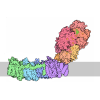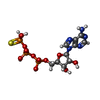[English] 日本語
 Yorodumi
Yorodumi- PDB-8rc5: Complex between the RecA-like Sak4 SSAP and the SaPI2 Stl master ... -
+ Open data
Open data
- Basic information
Basic information
| Entry | Database: PDB / ID: 8rc5 | ||||||||||||||||||||||||
|---|---|---|---|---|---|---|---|---|---|---|---|---|---|---|---|---|---|---|---|---|---|---|---|---|---|
| Title | Complex between the RecA-like Sak4 SSAP and the SaPI2 Stl master regulator | ||||||||||||||||||||||||
 Components Components |
| ||||||||||||||||||||||||
 Keywords Keywords | RECOMBINATION / Annealase / SSAP / Single Strand Annealing / Single Strand Binding / Recombineering / SaPI / Bacteriophage / Staphylococcal / Complex / SaPI induction / SaPI2 / Mobile Genetic Element / MGE / PICI / Phage-Inducible Chromosomal Island / C18 / Ring | ||||||||||||||||||||||||
| Function / homology |  Function and homology information Function and homology information | ||||||||||||||||||||||||
| Biological species |  Staphylococcus phage 52A (virus) Staphylococcus phage 52A (virus) | ||||||||||||||||||||||||
| Method | ELECTRON MICROSCOPY / single particle reconstruction / cryo EM / Resolution: 3.35 Å | ||||||||||||||||||||||||
 Authors Authors | Debiasi-Anders, G. / Mir-Sanchis, I. | ||||||||||||||||||||||||
| Funding support |  Sweden, 1items Sweden, 1items
| ||||||||||||||||||||||||
 Citation Citation |  Journal: Nat Commun / Year: 2025 Journal: Nat Commun / Year: 2025Title: Phage parasites targeting phage homologous recombinases provide antiviral immunity. Authors: Gianluca Debiasi-Anders / Cuncun Qiao / Amrita Salim / Na Li / Ignacio Mir-Sanchis /   Abstract: Bacteria often carry multiple genes encoding anti-phage defense systems, clustered in defense islands and phage satellites. Various unrelated anti-phage defense systems target phage-encoded ...Bacteria often carry multiple genes encoding anti-phage defense systems, clustered in defense islands and phage satellites. Various unrelated anti-phage defense systems target phage-encoded homologous recombinases (HRs) through unclear mechanisms. Here, we show that the phage satellite SaPI2, which does not encode orthodox anti-phage defense systems, provides antiviral immunity mediated by Stl2, the SaPI2-encoded transcriptional repressor. Stl2 targets and inhibits phage-encoded HRs, including Sak and Sak4, two HRs from the Rad52-like and Rad51-like superfamilies. Remarkably, apo Stl2 forms a collar of dimers oligomerizing as closed rings and as filaments, mimicking the quaternary structure of its targets. Stl2 decorates both Sak rings and Sak4 filaments. The oligomerization of Stl2 as a collar of dimers is necessary for its inhibitory activity both in vitro and in vivo. Our results shed light on the mechanisms underlying antiviral immunity against phages carrying divergent HRs. | ||||||||||||||||||||||||
| History |
|
- Structure visualization
Structure visualization
| Structure viewer | Molecule:  Molmil Molmil Jmol/JSmol Jmol/JSmol |
|---|
- Downloads & links
Downloads & links
- Download
Download
| PDBx/mmCIF format |  8rc5.cif.gz 8rc5.cif.gz | 1.5 MB | Display |  PDBx/mmCIF format PDBx/mmCIF format |
|---|---|---|---|---|
| PDB format |  pdb8rc5.ent.gz pdb8rc5.ent.gz | Display |  PDB format PDB format | |
| PDBx/mmJSON format |  8rc5.json.gz 8rc5.json.gz | Tree view |  PDBx/mmJSON format PDBx/mmJSON format | |
| Others |  Other downloads Other downloads |
-Validation report
| Summary document |  8rc5_validation.pdf.gz 8rc5_validation.pdf.gz | 1.3 MB | Display |  wwPDB validaton report wwPDB validaton report |
|---|---|---|---|---|
| Full document |  8rc5_full_validation.pdf.gz 8rc5_full_validation.pdf.gz | 1.4 MB | Display | |
| Data in XML |  8rc5_validation.xml.gz 8rc5_validation.xml.gz | 141.3 KB | Display | |
| Data in CIF |  8rc5_validation.cif.gz 8rc5_validation.cif.gz | 198.3 KB | Display | |
| Arichive directory |  https://data.pdbj.org/pub/pdb/validation_reports/rc/8rc5 https://data.pdbj.org/pub/pdb/validation_reports/rc/8rc5 ftp://data.pdbj.org/pub/pdb/validation_reports/rc/8rc5 ftp://data.pdbj.org/pub/pdb/validation_reports/rc/8rc5 | HTTPS FTP |
-Related structure data
| Related structure data |  19048MC  8pq8C  8q86C  8qe9C M: map data used to model this data C: citing same article ( |
|---|---|
| Similar structure data | Similarity search - Function & homology  F&H Search F&H Search |
- Links
Links
- Assembly
Assembly
| Deposited unit | 
|
|---|---|
| 1 |
|
- Components
Components
| #1: Protein | Mass: 31653.682 Da / Num. of mol.: 18 Source method: isolated from a genetically manipulated source Source: (gene. exp.)  Staphylococcus phage 52A (virus) / Plasmid: pET28a / Production host: Staphylococcus phage 52A (virus) / Plasmid: pET28a / Production host:  #2: Protein | Mass: 27189.562 Da / Num. of mol.: 18 Source method: isolated from a genetically manipulated source Source: (gene. exp.)   #3: Chemical | ChemComp-AGS / Has ligand of interest | N | Has protein modification | N | |
|---|
-Experimental details
-Experiment
| Experiment | Method: ELECTRON MICROSCOPY |
|---|---|
| EM experiment | Aggregation state: PARTICLE / 3D reconstruction method: single particle reconstruction |
- Sample preparation
Sample preparation
| Component | Name: Complex between Sak4 SSAP from staphylococcal phage 52A and the SaPI2 Stl master regulator Type: COMPLEX / Entity ID: #1-#2 / Source: RECOMBINANT | |||||||||||||||||||||||||
|---|---|---|---|---|---|---|---|---|---|---|---|---|---|---|---|---|---|---|---|---|---|---|---|---|---|---|
| Molecular weight | Experimental value: NO | |||||||||||||||||||||||||
| Source (natural) | Organism:  | |||||||||||||||||||||||||
| Source (recombinant) | Organism:  | |||||||||||||||||||||||||
| Buffer solution | pH: 7 Details: 100mM NaCl, 20mM Tris-HCl pH 7.0, 1mM DTT and 2mM ATPyS. No metal was added. | |||||||||||||||||||||||||
| Buffer component |
| |||||||||||||||||||||||||
| Specimen | Conc.: 1 mg/ml / Embedding applied: NO / Shadowing applied: NO / Staining applied: NO / Vitrification applied: YES / Details: Monodisperse sample. | |||||||||||||||||||||||||
| Specimen support | Grid material: COPPER / Grid mesh size: 300 divisions/in. / Grid type: Quantifoil R2/1 | |||||||||||||||||||||||||
| Vitrification | Instrument: FEI VITROBOT MARK IV / Cryogen name: ETHANE / Humidity: 100 % / Chamber temperature: 277 K |
- Electron microscopy imaging
Electron microscopy imaging
| Microscopy | Model: TFS GLACIOS |
|---|---|
| Electron gun | Electron source:  FIELD EMISSION GUN / Accelerating voltage: 200 kV / Illumination mode: FLOOD BEAM FIELD EMISSION GUN / Accelerating voltage: 200 kV / Illumination mode: FLOOD BEAM |
| Electron lens | Mode: BRIGHT FIELD / Nominal magnification: 190000 X / Nominal defocus max: 2400 nm / Nominal defocus min: 1200 nm / Cs: 2.7 mm |
| Specimen holder | Cryogen: NITROGEN |
| Image recording | Electron dose: 50 e/Å2 / Film or detector model: TFS FALCON 4i (4k x 4k) / Num. of grids imaged: 1 / Num. of real images: 1301 |
- Processing
Processing
| EM software |
| |||||||||||||||||||||||||||||||||||
|---|---|---|---|---|---|---|---|---|---|---|---|---|---|---|---|---|---|---|---|---|---|---|---|---|---|---|---|---|---|---|---|---|---|---|---|---|
| CTF correction | Details: CTF correction was applied on-the-fly during data collection with CryoSPARC Live. Type: PHASE FLIPPING AND AMPLITUDE CORRECTION | |||||||||||||||||||||||||||||||||||
| Symmetry | Point symmetry: C2 (2 fold cyclic) | |||||||||||||||||||||||||||||||||||
| 3D reconstruction | Resolution: 3.35 Å / Resolution method: FSC 0.143 CUT-OFF / Num. of particles: 141863 Details: Symmetry-expanded to D1, doubling the particle stack, from 141863 to 283726 particles. Symmetry type: POINT |
 Movie
Movie Controller
Controller





 PDBj
PDBj






